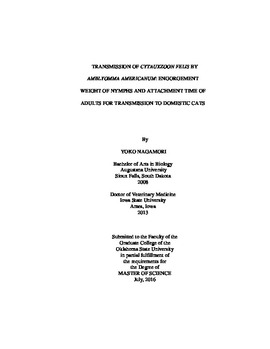| dc.contributor.advisor | Reichard, Mason V. | |
| dc.contributor.author | Nagamori, Yoko | |
| dc.date.accessioned | 2017-02-22T22:15:53Z | |
| dc.date.available | 2017-02-22T22:15:53Z | |
| dc.date.issued | 2016-07-01 | |
| dc.identifier.uri | https://hdl.handle.net/11244/49122 | |
| dc.description.abstract | Cytauxzoon felis causes the most severe tick-borne disease of domestic cats in the United States. The geographic distribution and prevalence of cytauxzoonosis seem to be increasing as the range of Amblyomma americanum expands. However, disease prevalence and life cycle have not been completely understood, and diagnosis and treatment remain challenging. My research focused on determining the prevalence of C. felis, a better understanding of life cycle, and developing supportive diagnostic techniques.To contribute establishing the prevalence of C. felis in domestic cats, blood was collected from 380 free-roaming cats in 2014 in Oklahoma and 292 in 2012�2014 in Iowa. PCR detected C. felis DNA in 3 of 380 (0.8%; 0.22�2.3%) feline samples from OK and 0 of 292 (0.0%; 0.0�1.3%) from IA. Prevalence of C. felis infection was examined in C. felis-exposed A. americanum using staining technique and PCR. Cytauxzoon felis-infected salivary glands were not observed in 350 fed ticks (0.0%; 0.0�1.0%), whereas 54 of 352 (15.3%; 11.7�19.5%) salivary glands from flat ticks were infected with C. felis. PCR detected C. felis DNA in 4 of 358 (1.1%; 0.30�2.84%) ticks. Transmission of C. felis from A. americanum to a domestic cat was demonstrated in <72 hours. Tick morphometric method was examined as a supportive diagnostic technique and shown to be less practical to predict probability of transmission. Additionally, nymphal sexual dimorphism was examined with A. americanum, A. maculatum, Dermacentor andersoni, D. variabilis, and Rhipicephalus sanguineus. The mean body weight of engorged nymphs that became females was significantly greater than that of nymphs that molted to males in A. americanum (t=32.3; P<0.0001), A. maculatum (t=-9.70; P<0.0001), D. variabilis (t=15.7; P<0.0001), and R. sanguineus (t=5.17; P<0.0001), whereas, the mean body weight of D. andersoni engorged nymphs that became males was significantly greater (t=8.71; P<0.0001) than that of nymphs that molted to females. Overall, these studies have contributed to a better understanding of the prevalence of C. felis and life cycle with timing of transmission. Additionally, the findings in nymphal sexual dimorphism may help explain potential differences in prevalence of tick-borne pathogens between female and male ticks. | |
| dc.format | application/pdf | |
| dc.language | en_US | |
| dc.rights | Copyright is held by the author who has granted the Oklahoma State University Library the non-exclusive right to share this material in its institutional repository. Contact Digital Library Services at lib-dls@okstate.edu or 405-744-9161 for the permission policy on the use, reproduction or distribution of this material. | |
| dc.title | Transmission of Cytauxzoon Felis by Amblyomma Americanum: Engorgement Weight of Nymphs and Attachment Time of Adults for Transmission to Domestic Cats | |
| dc.contributor.committeeMember | Little, Susan E | |
| dc.contributor.committeeMember | Meinkoth, James | |
| dc.contributor.committeeMember | Payton, Mark | |
| osu.filename | Nagamori_okstate_0664M_14763.pdf | |
| osu.accesstype | Open Access | |
| dc.description.department | Veterinary Biomedical Sciences | |
| dc.type.genre | Thesis | |
| dc.type.material | text | |
